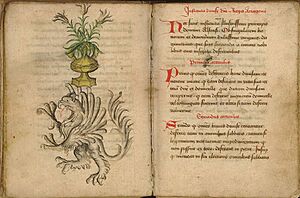Order of the Jar facts for kids
The Order of the Jar was a special group of knights, like a club for brave and loyal people. It was started by Ferdinand of Antequera in 1403. Later, when Ferdinand became the King of Aragon in 1412, it became a royal order. This means it was officially connected to the king and his family. The order lasted for over 100 years, until 1516.
Contents
Different Names for the Order
This knightly order was known by several names over time. Each name often highlighted a different symbol or idea connected to the group. Some of its names included:
- Order of the Jar of the Salutation
- Order of the Jars of Saint Mary and the Griffin
- Order of the Jar and the Griffin
- Order of the Lily
- Order of the Griffin
The Story of Its Beginning
There's a famous story about how the Order of the Jar supposedly began much earlier than 1403. This legend might have been created to make Ferdinand's new order seem older and more important.
According to the legend, the order started in the Kingdom of Navarre in the 11th century. One popular version tells of King García Sánchez III of Navarre. On March 25, 1043, he was hunting with his falcon. The falcon was chasing a pigeon, and both birds flew into a cave in a place called Nájera.
Inside the cave, King García found a statue of the Virgin Mary. Next to her was a jar filled with lilies. Lilies are a symbol of purity and are often linked to the Annunciation, which is when the angel Gabriel told Mary she would have a special baby.
Because of this discovery, King García decided to build a monastery near the cave. This monastery became known as Santa María la Real of Nájera. At the same time, he supposedly created the Orden de la Terraza, which is an old word for "Order of the Jar."
How the Order Was Officially Started
The Order of the Jar was officially founded on August 15, 1403. On this day, Ferdinand of Antequera gave a special "collar" to his sons. This collar was a symbol of their membership in the new knightly order. His sons included Alfonso V of Aragon, John II of Aragon and Navarre, and others.
The main symbol of the order was a chain with a jar of lilies hanging from it. This jar of lilies represented the purity of the Virgin Mary. Also on the chain was a griffin. A griffin is a mythical creature with the body of a lion and the head and wings of an eagle. It was a symbol of strength and was meant to represent fighting against enemies. Members of the order also wore a white cloth called a stole.
The rules of the order were written down in a document called Reglas y Divisa de la Orden Militar de la Jarra. These rules explained the meaning behind the symbols. They said that the griffin showed that members should be "strong and firm in the love of God and of the Virgin St Mary."
Becoming a Royal Order
When Ferdinand became the King of Aragon, the Order of the Jar became a royal order. This meant it was closely tied to the royal family and their kingdoms, including Aragon, Sicily, and later Naples.
Even though it wasn't as big as some other royal orders, it was important in royal ceremonies. For example, during Ferdinand's coronation in Zaragoza in 1414, the order played a central role.
After a battle called the siege of Balaguer in 1413, Ferdinand honored about eighty brave knights by giving them the order's shield.
Ferdinand also allowed other important people to join the order. In 1415, he made King Sigismund of Germany a member during a visit to Perpignan.
Ferdinand's son, Alfonso V of Aragon, brought the order to the Kingdom of Naples after he took control of it in 1443. The order was also introduced to Navarre by Alfonso's son, John II of Aragon and Navarre, after 1458.
See also
 In Spanish: Orden de la Terraza para niños
In Spanish: Orden de la Terraza para niños


